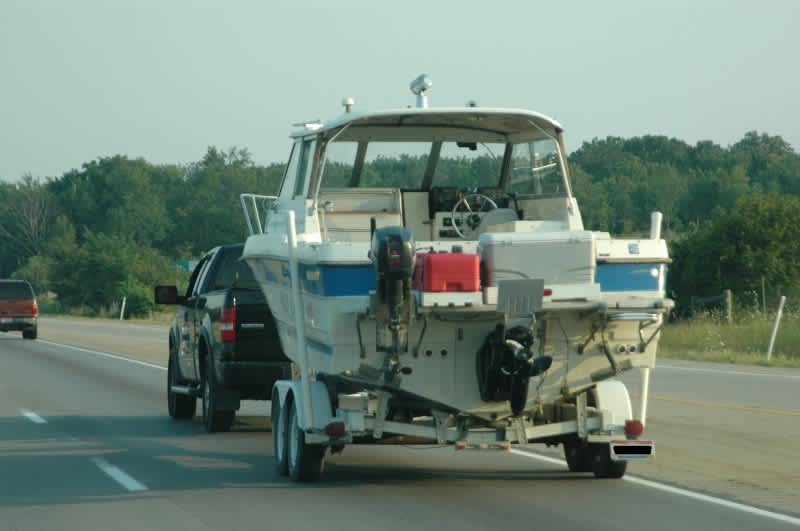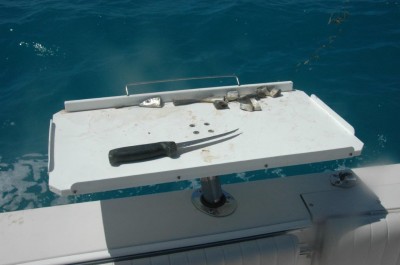Eleven Essentials for Saltwater Rigging
Dan Armitage 12.28.13

If you are heading south for a fishing vacation this winter and plan to trailer your freshwater boat, here are 11 things to bring to allow you to be better prepared for fishing in saltwater.
Portable VHF Radio
For everything from current weather reports and sea conditions to listening in on local anglers to learn where the fishing action is taking place (let alone being able to summon assistance in the event of an emergency), a VHF radio is essential for coastal fishing.
Current charts of the waters you will be boating
The reasons for this item are obvious, and I like Waterproof-brand charts because they hold up well despite being rolled, folded, unrolled, unfolded, and getting wet—and they float.
Portable bait container
Much of the fishing done in saltwater includes the use of live bait, most commonly shrimp or minnows or crabs, and you need to be able to keep the critters alive and kicking over the course of a fishing day (and night). I’ve taken delivery on too many fishing boats that came equipped with baitwells—but no pumps or plumbing—to leave home without a bait bucket or portable bait container. I like the Frabill Flow Troll bucket because its design allows me to drag it slowly behind the boat to keep water flowing through holes in the bucket to the bait, and bring the pail and its contents aboard without having to place it in a separate bucket or well. Make sure you have a line attached to the handle of any bucket so that it can be tethered to the boat or dock. You can also consider portable battery-powered baitwells, several models and styles of which are available that use everything from small buckets to oversized coolers as their bait basins.

Cutting board and knife
Saltwater fishing often involves cutting fish for chum and bait. I learned the hard way that composite hatch covers show every slice of a knife used to dice a fish positioned atop one, so I take along a common cutting board of wood or nylon. Recently I found nylon cutting boards fitted with suction cups to hold onto flat surfaces that work well. As for a knife, my wife prefers that we take two when heading to the ocean: one for cutting bait and one for filleting the catch for dinner.
Needle-nosed pliers
Lots of saltwater gamefish have teeth, and because you may be using live or cut bait that fish tend to swallow, you’ll need the extra reach offered by the slender jaws of these pliers. The wire-cutting capability will come in handy when you have to twist wire leaders, cut heavy mono or superbraids, or clip off a hook barb before removing it from your hide.
Boga-Grip
These lip-locking devices allow you to land even the toothiest fish without a net, or to control a fish in the water while removing a hook when practicing catch and release. I like the original, stainless-steel Boga brand, which are very well-made, stand up to the salt, and have a scale built into the handle to allow you to weigh your catch without touching the fish.

Extra anchor and line
I have a five-gallon bucket filled with 75 feet of half-inch diameter Dacron line attached to five feet of chain and a grapple-style anchor that goes aboard every boat I rig and test for saltwater. I take along a 10-pound Danforth as well, until I confirm with my own eyes that the boat has a traditional anchor of adequate size and enough line to hold the boat. I take the extra line and the grapple anchor aboard regardless, and use the hook to hold me on wrecks and rocks and have the line as a back-up to extend the rode that comes with the boat in the event I need the extra scope.
Cell phone case
Take your cell phone in a waterproof pouch and program into the speed-dial function the numbers of the local US Coast Guard, the harbor- or dock-master at your host marina, and anyone else you may want to contact if you need assistance on the water.
Mooring lines
I have four 10-foot lines of half-inch Dacron that go in the anchor line bucket. They are looped at one end, so that I can quickly attach them together to have 40 feet of line if I need it, or keep them separate as dock lines, bait bucket tethers, or swim lines.
Engine flush kit
You’ll want to flush your boat engine’s lower unit free of saltwater after each use, so take a short length of hose with the proper connection for your engine or, as I do, bring along an “ear muff”-style flusher that is adaptable to most lower units.
Extra deep-cycle battery
An extra deep-cycle battery aboard serves as a back-up to the starting battery and offers more juice as needed to power accessories that you may not be accustomed to operating, including sonar, GPS, baitwells, and livewells that may drain their primary cell before you are aware of their draw.

